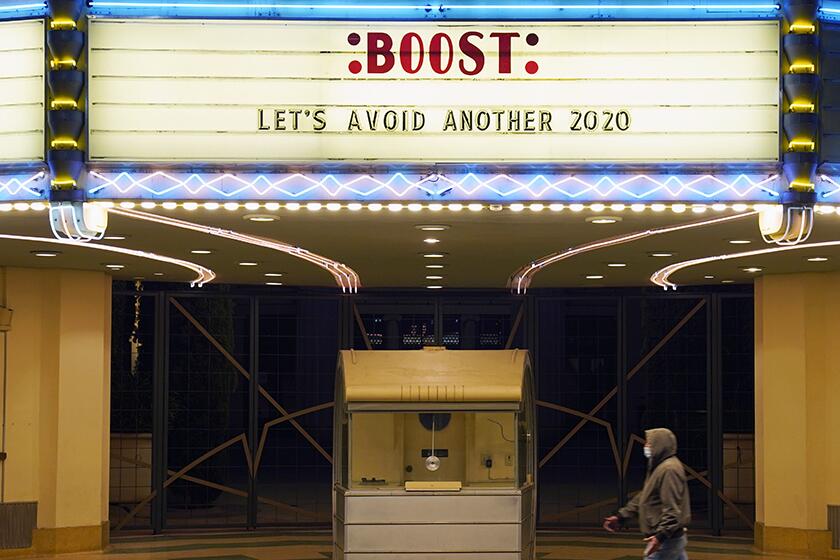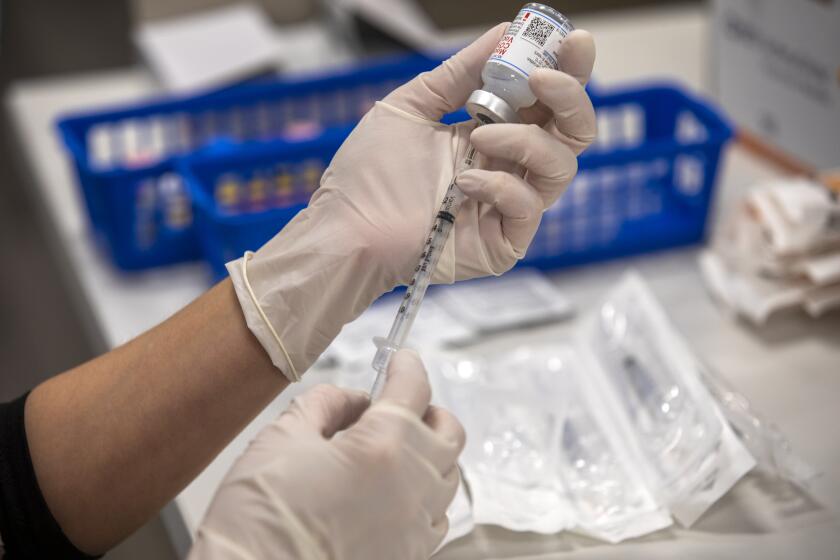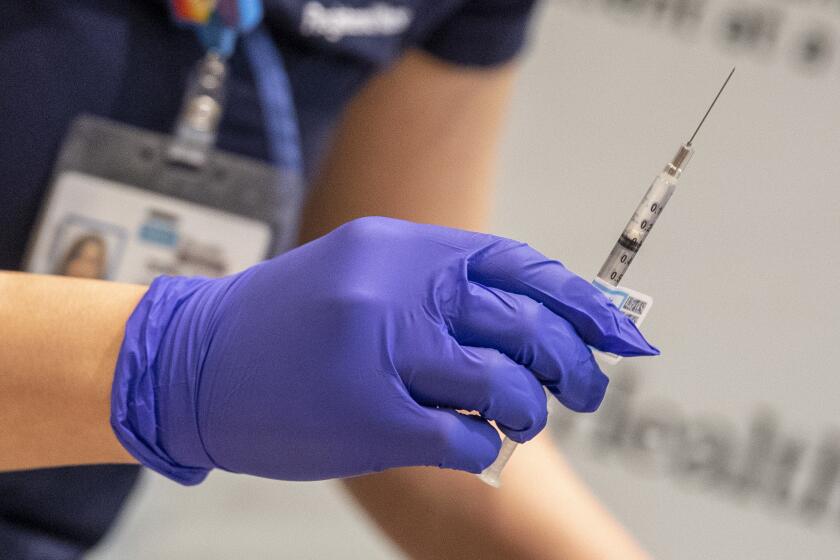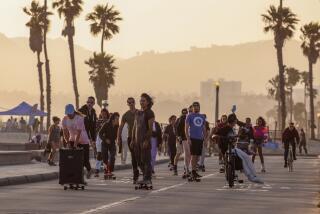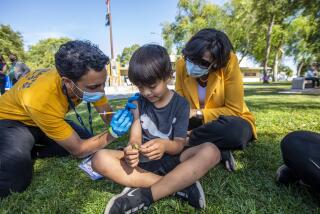CDC endorses booster shots that target Omicron for Americans 12 and up
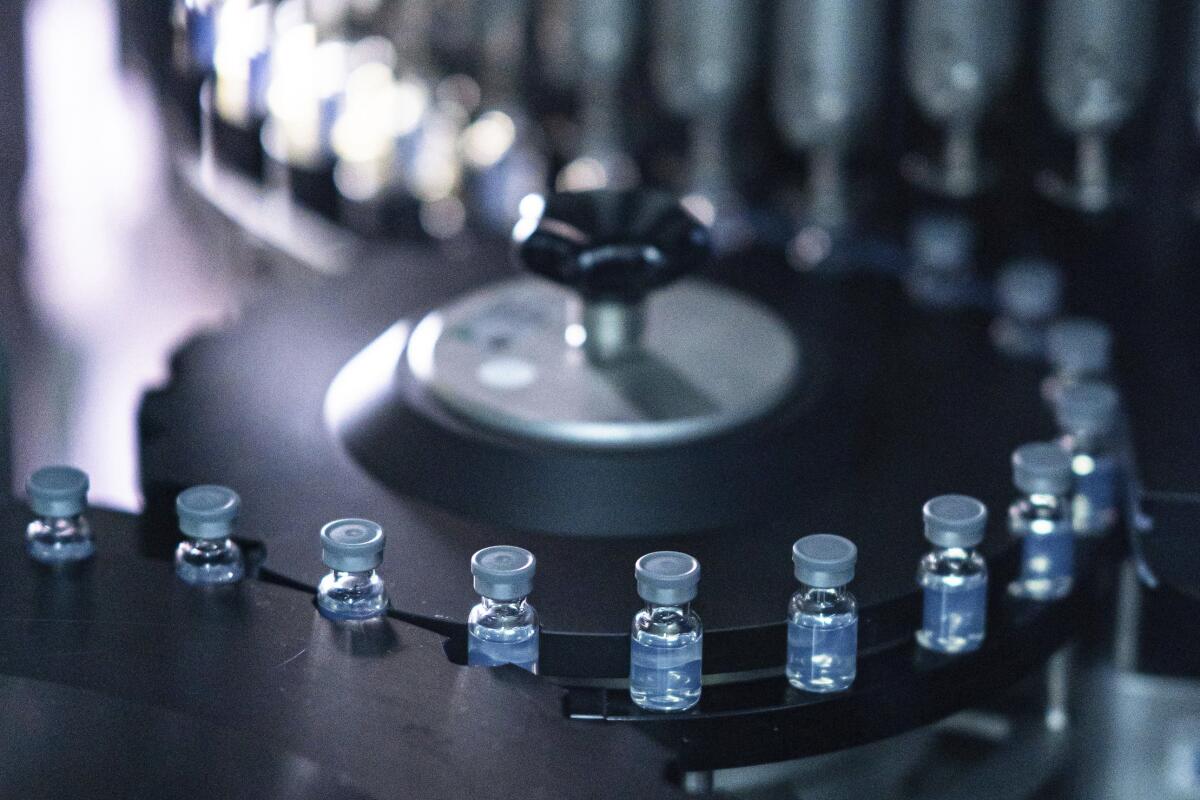
- Share via
The United States will replace most of its COVID-19 booster shots with updated versions that target the dominant Omicron strains and streamline its ongoing vaccination campaign, the Centers for Disease Control and Prevention announced Thursday.
Under the new plan, Americans ages 12 and up will be asked to roll up their sleeves for the reformulated boosters, which are engineered to combat the BA.4 and BA.5 subvariants along with the original coronavirus that arrived in the U.S. in early 2020. The “bivalent” boosters could begin going into arms in a matter of days.
People will be eligible for the new shots if it’s been at least two months since their last dose. About 209 million Americans currently meet those criteria; most of them haven’t received a shot in more than six months.
The change was recommended Thursday by the Advisory Committee on Immunization Practices, an influential group of vaccine experts that provides guidance to the CDC. Dr. Rochelle Walensky, the agency’s director, quickly accepted the group’s advice.
The two offerings — one from Pfizer and BioNTech for people 12 and older and another from Moderna for adults 18 and over — represent the first substantial change to the COVID-19 vaccine recipe since the country’s immunization campaign began nearly two years ago. The original boosters that don’t target BA.4 and BA.5 will no longer be available to those 12 and up.
“The updated COVID-19 boosters are formulated to better protect against the most recently circulating COVID-19 variant,” Walensky said in a statement. “If you are eligible, there is no bad time to get your COVID-19 booster and I strongly encourage you to receive it.”
The CDC also revised its accounting of vaccine doses. Going forward, Americans will be considered “up to date” with their COVID-19 vaccinations after receiving the bivalent booster, regardless of the total number of shots they’ve received.
“I think this is a huge step forward in simplifying the recommendations and hopefully enhancing coverage,” said Dr. Katherine Poehling, a pediatrician at Wake Forest School of Medicine who serves on the CDC advisory committee.
People who’ve had a recent coronavirus infection are advised to wait at least three months after their positive coronavirus test or the onset of their COVID-19 symptoms before getting the new shot.
Determining which version of the coronavirus should be used to make COVID-19 vaccines and boosters is an exercise in educated guesswork.
President Biden and members of his COVID-19 response team have been touting a fall booster campaign centered on the bivalent vaccine. The administration has already purchased 171 million doses.
“It’s going to be really important that people this fall and winter get the new shots,” White House COVID-19 coordinator Dr. Ashish Jha said last month. “It’s designed for the virus that’s out there.”
And because the updated boosters will train the immune system to recognize the dominant BA.4 and BA.5 strains, he added, they’re expected to enhance the vaccines’ “ability to prevent infection, to prevent transmission, certainly to prevent serious illness and death.”
A team of disease-modeling experts from around the country projects that making the new booster available to adults in September instead of waiting until November could prevent 137,000 hospitalizations due to COVID-19 and avert 9,700 deaths. They also forecast that rolling out the new booster to all adults instead of limiting it to those 50 and older would reduce hospitalizations by 20% and deaths by 15%.
A separate study by the Commonwealth Fund estimated that launching a booster campaign in early fall could save between $63 billion and $109 billion, mostly in hospitalization costs.
The U.S. Food and Drug Administration authorized the two bivalent boosters Wednesday after tests on animals showed “a very good immune response,” said Dr. Peter Marks, the agency’s vaccine chief.
The new Omicron-specific COVID booster shots should be available for eligible residents come mid-September, officials say.
In a move that echoes the annual update of the flu vaccine formulation, the FDA did not require additional tests in people before acting. Both companies said human trials of the new boosters are ongoing, but the lack of data made some panel members uneasy.
“I understand we need better vaccines,” said Dr. Pablo Sanchez, a pediatric infectious diseases expert at Nationwide Children’s Hospital in Columbus, Ohio. “But I’m struggling with making a recommendation for a vaccine, a bivalent vaccine ... that has not been studied in humans.” He was the only panel member to vote against the recommendation.
Dr. Matthew Daley, a researcher at Kaiser Permanente Colorado, agreed that clinical data would be reassuring. But considering that the pandemic is still causing about 85,000 infections and 400 deaths each day in the U.S. alone, Daley said the risks of waiting for that data outweighed the risks of moving ahead with the new boosters.
“I think they’re going to be an effective tool for disease prevention this fall and into the winter,” he said.
Another bivalent vaccine from Moderna that targets the original Omicron strain, known as BA.1, was authorized by the United Kingdom’s Medicines and Healthcare Products Regulatory Agency last month. When tested in people, the side effects were similar to those seen with the original vaccine and were typically “mild and self-resolving,” according to the agency.
Pfizer was also developing a bivalent vaccine aimed at BA.1. But the FDA said in June that the only tweaked boosters it was interested in were ones that target BA.4 and BA.5. Together, the two subvariants account for about 92% of the COVID-causing viruses now circulating in the U.S., according to CDC estimates. They have identical spike proteins, which is the part of the virus the vaccine is trained to recognize.
While the original vaccines and boosters have proved effective at preventing serious illnesses and death, the hope is that the new shots will be more effective at warding off infections. There’s reason to think they will: Both Pfizer and Moderna said their BA.1 boosters prompted recipients to produce higher levels of Omicron-fighting antibodies compared with booster doses of their original vaccines.
In addition, Moderna officials presented data to the advisory committee showing that compared to people who had a traditional second booster, those who got their BA.1 shot produced modestly higher levels of antibodies to the Alpha, Beta, Delta and Gamma variants. That’s in line with experiments showing that exposure to a wider range of coronaviruses makes the immune system better equipped to handle ones it’s never seen before.
Researchers at Caltech have developed a vaccine designed to neutralize multiple coronaviruses at the same time.
Walensky’s decision is the last federal barrier to getting the new shots to the public. But before they can be made available in California, they’ll need the blessing of the Western States Scientific Safety Review Workgroup, an independent board of public health experts that reviews COVID-19 vaccines. Officials expect the shots to be available here soon after Labor Day.
Los Angeles County has placed an order for 170,000 doses of the boosters, the maximum amount currently allowed. Those are expected to arrive between Sept. 6 and Sept. 9 and will be distributed to roughly 300 healthcare providers by the middle of the month, according to Public Health Director Barbara Ferrer.
Both companies are still developing bivalent shots for younger kids, which could be ready within a few months. In the meantime, children 11 and under will have to stick with the original booster formulations.
Ultimately, the shots’ ability to prevent the next wave will depend on how many people choose to get them. Although more than two-thirds of all Americans have completed their primary series of COVID-19 shots, only 48.5% of those eligible for a first booster have received it. And only 33.7% of Americans 50 and older who are able to get a second booster dose have done so, according to the CDC.
In a survey conducted by the CDC, 72% of those polled said they would get the new booster.
